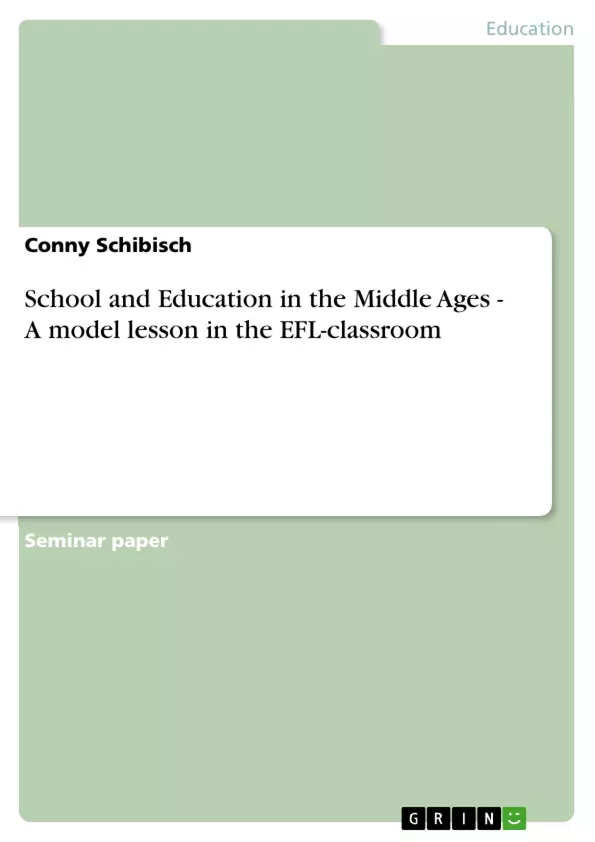This paper will deal with a model lesson on school and education in the Middle Ages (=MA) and Early Renaissance1. It is an approach to show that not only classical topics should have a place in the EFL-classroom. After showing the reader the relevance of teaching the MA in general in class there will be an intense inside look on the educational situation in England in the time roughly between 1000 and 1600. The main focus will not be the exact development of education and educational institutions during the medieval period, but it will be the analysis of the different types of education and ways of teaching different genders. These descriptions and analyses will turn out to be the background for the didactic approach to four model lessons on this topic in the EFL-classroom.
As there are no explicit drafts of how to deal with school and education in the MA in the English classroom the approach cannot be proved on theoretical background. All ideas for texts, exercises and teaching material are purely theoretical and cannot be found as a collection in didactic literature. Therefore it is only speculation if the way the topic is illustrated here will work in real life.
The model lessons presented here will be embedded in a series of lessons dealing with the MA in general because
“(…) the student will benefit from a holistic, integrated picture of the Middle Ages - or of anything else, for that matters - than from a loose collection of assorted but unrelated bits of knowledge. Meaningful learning is based on understanding relationships and contexts, not on the acquisition of unconnected facts. Meaningful learning is contextual learning.”
After talking about different aspects of the MA e.g. about society, literature and history the pupil will have a good impression of this period and may see and understand connections between those days and the time they live in.
Table of Contents
- Introduction
- Structure
- Why is teaching the MA in the EFL-classroom of importance?
- Main Part
- School and education in the Middle Ages
- Why is talking about school and education in the Middle Ages important?
- Historic background
- Infancy and family life
- Games and play
- Church
- Schooling
- Educational system
- Literacy
- Basic education
- Learning to read
- Didactic material
- Children's literature
- Books in use
- Children-adult-relationship
- School life in a boarding school
- The master
- Universities and colleges
- The model lessons - an approach
- Setting of the model lessons in the Middle Ages sequence
- Class situation
- Aim of the projected model lessons
- Usage of media
- First double lesson
- Structure of projected lesson
- Detailed description of projected lesson
- Homework control
- Motivation/Introduction to new subject matter
- Assimilation/Application
- Homework
- Second double lesson
- Structure of projected lesson
- Detailed description of projected lesson
- Warming-up
- Application
- School and education in the Middle Ages
- Outlook
Objectives and Key Themes
This paper aims to present a model lesson on school and education in the Middle Ages, demonstrating the relevance of this topic in the EFL classroom. It focuses on the educational landscape in England between 1000 and 1600, examining the various forms of education and teaching methods for different genders. The model lessons are designed to offer a didactic approach to this subject in an EFL context.
- The importance of teaching medieval literature and culture in the EFL classroom.
- The educational system and practices in England during the Middle Ages.
- The role of gender in education during this period.
- The development of didactic approaches to teaching medieval topics in the EFL classroom.
- The relevance of medieval culture to modern society and the contemporary “renaissance of the Middle Ages.”
Chapter Summaries
The paper begins by exploring the significance of teaching medieval literature and culture in the EFL classroom, highlighting the importance of understanding historical contexts and the enduring influence of the past on the present. It argues that while teaching original medieval literature can be challenging, the topic holds value for pupils, offering insights into the origins of various institutions and cultural practices. The paper then delves into the historical background of education in England, examining family life, games, the role of the Church, and the development of schools and universities.
The paper then presents a detailed analysis of the different types of education available in the Middle Ages, including the educational system, literacy, basic education, learning to read, didactic materials, children's literature, print, books in use, the relationship between children and adults, and school life in a boarding school. The analysis also explores the role of the master and the significance of universities and colleges. The paper concludes by outlining a series of model lessons designed to engage students in the study of medieval education.
Keywords
This paper centers around the key themes of medieval education, EFL pedagogy, medieval literature, historical context, didactic methods, gender in education, and the relevance of the Middle Ages to modern society. The discussion highlights the importance of fostering a holistic understanding of the Middle Ages and its lasting impact on contemporary culture. It also emphasizes the value of incorporating historical perspectives into English language teaching.
- Citation du texte
- Conny Schibisch (Auteur), 2003, School and Education in the Middle Ages - A model lesson in the EFL-classroom, Munich, GRIN Verlag, https://www.grin.com/document/66873



